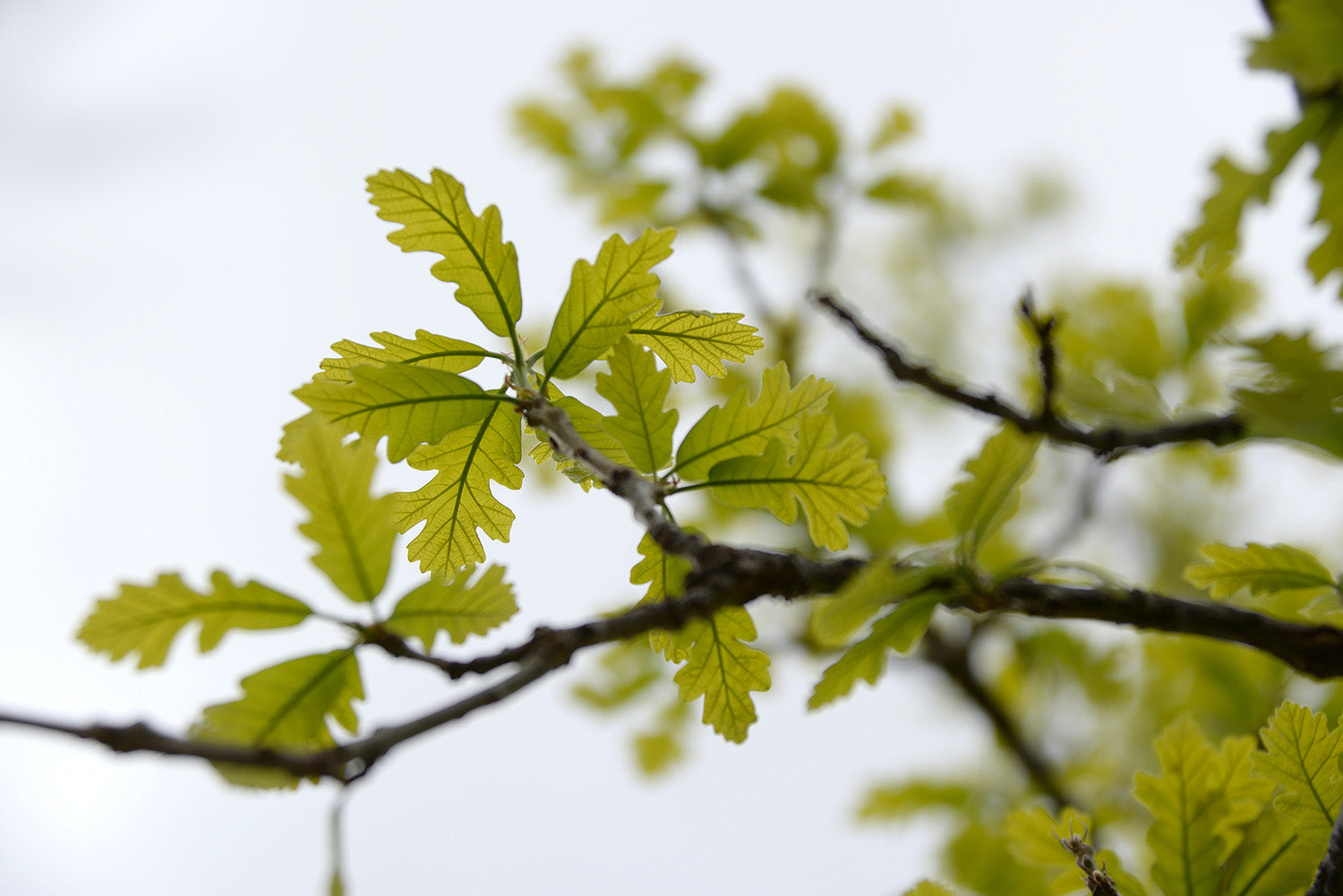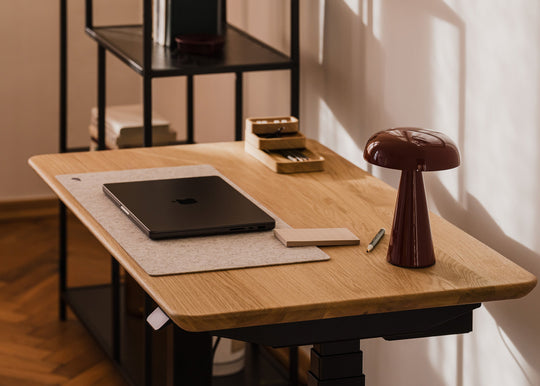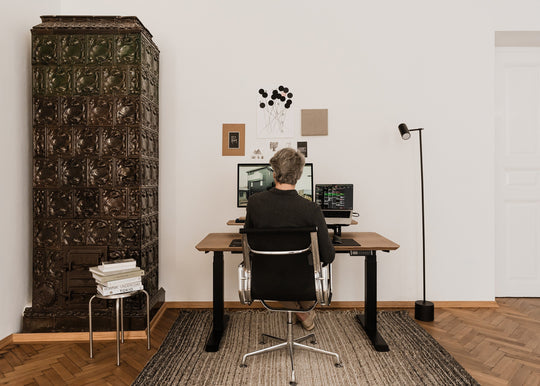
The lifecycle of Oakywood’s wooden products
Sustainable production begins much earlier than expected – before the materials get to the workshop, decisions regarding their source need to be made. This blog post will walk you through the manufacturing process of our desks and office accessories – from raw materials into finished products ready to be shipped. Together with one of our wood suppliers, the sawmill Kleniewski Tartak, we have compiled some interesting ‘behind the scenes’ facts about the production of Oakywood’s wooden accessories.

Renewable resources – FSC certified wood
It all begins in the forest. Each of our wooden products is a part of the forest and, as such, can serve as a connector between man and nature.
We care deeply about sustainable production which is why we use renewable resources from our trusted distributors. One of them, the sawmill Kleniewski Tartak, provides us with FSC-certified, Polish oak wood obtained from state-owned forests. The FSC certification is awarded by a non-governmental organization, the Forest Stewardship Council, and indicates that the materials are sourced in an eco-friendly way. The FSC makes sure that the methods of extraction preserve biodiversity and integrity of the forest structure – in other words, it supports sustainability in forest management.
For a company to receive the FSC certification, it needs to uphold appropriate standards throughout each stage of sourcing and processing of the raw material: from cutting down the tree, through woodworking, manufacturing wooden products, packaging, distribution, and sales. Interestingly, the certificate is not granted permanently, it is valid for a period of 5 years from the moment the certification audit is completed.

Photo by Annie Spratt on Unsplash
Why oak?
The pedunculate (or ‘common’) oak is – besides American walnut – one of the key materials used at Oakywood, and the leading raw material processed by Kleniewski Tartak. By choosing this specific species of timber, we lean into its rich history and symbolism from the very distant past. Ancient Greeks considered oak to be a symbol of longevity, strength, and power – it was thought to be Zeus’ tree. In ancient Rome, it was customary to place a crown made of oak leaves onto the heads of exceptionally accomplished citizens. According to Slavic mythology, it was strongly associated with Perun and treated as a magical tree with healing powers. Oak wood was also the material chosen by the Vikings to build their boats.
Oak wood’s popularity is unwavering – it is sought after due to its unique look, elegance, and practical properties. Oak is amazingly sturdy and durable, characterized by high density (0,75g/cm3), resistance to wear as well as mechanical damage and moisture. Thanks to the tannins in its bark, oak is also highly immune to being attacked by fungus or insects.
The visual appeal of oak lies in the presence of large-diameter vessels and the significant difference between the earlywood (where the vessels form), and latewood, which create a beautiful design with distinct rings.
Apart from the pedunculate oak, we also deal with cork-oak – or rather with the cork from the oak tree. Cork-oak is a species native to the Mediterranean climate and Portugal is its leading supplier - this is where we source the material we use at the base of products such as the Felt&Cork Desk Mat or the OakyBlocks modules. Portuguese cork is also obtained in a safe and eco-friendly way which guarantees the tree’s full regeneration: the layer of dead bark is carefully stripped from the tree and can grow back. The tree needs to be at least 25 years old to have this done.

Producing lumber – the early stages of wood processing
Even though oak is a relatively adaptable material to work with, its initial processing is no easy task.
Oak timber production is difficult. Planning the cut is often problematic due to the versatility and uniqueness of the wood’s structure. The operator must decide, in real time, what product can be made from a particular log, which directly impacts the quality of the timber.
CEO of Kleniewski TartakAfter delivering the longwood oak from the forest to the sawmill, it needs to be cut and debarked. The logs are inspected with a metal detector - if any metal is detected, the wood has to go through separate processing procedures. If the log is, however, clean of metal, it is handed over to the cutting station: the bandsaw operator then decides on the thickness of planks to be cut from it. The logs are chopped in the most efficient way possible.
The next step after carving the planks is stacking and sending them to the drying chambers – depending on the thickness of the sawn wood, the drying process can take from 1,5 to 3,5 months. Dried planks are then sorted according to their quality, measured, and packaged. This is the moment when the oak lumber makes its way from the sawmill Kleniewski Tartak to our Ciche workshop.

Photo by Designed by Kirk
From plank to Desk Shelf: production process at the Oakywood workshop
Zero-waste is the number one rule in our workshop: we try our best to use all the lumber we get delivered. We usually use 52mm thick planks to make our desks but also smaller accessories such as the Triple Dock, Laptop Dock and versatile wooden containers which can be used as planters or pen holders (Geometric Pot, Cubic Pot).
Upon receiving the planks from the sawmill, we cut them at the pith, right in the middle, to prevent the wood from warping at later stages of production. The planks are then whittled to a desired thickness using a machine called the thicknesser, and – depending on the desired product – they are either joined or milled. The smaller accessories are made from one piece of solid wood, whereas desks require a few different staves. In order to produce the most visually uniform tabletop, we meticulously sort the planks by quality and color.
Each plank can have a unique grain pattern: curly or straight, with subdued rings, or striped. No two planks are the same which means every one of our products has a different grain design.
Oakywood Production ManagerApart from its grain pattern, oak wood is known for its medullary rays which appear as white, ribbon-like designs on the surface of the wood. The rays are made up of cells which serve very important functions: for example, they ensure consistent air supply to the center of the trunk and facilitate conduction of water from the center towards phloem and cambium. Although medullary rays are sometimes considered to be defects, they are what makes oak wood look so noble and unique.
Once the milling is done, some pieces are sanded to finally take their specific forms. The last stage consists of covering the wooden surfaces with eco-friendly oil wax which preserves the wood’s natural coloring. Now all that is left to do is add additional elements (for example felt or cork) and the product can be packaged before embarking on its most important journey: the journey to your home office.









